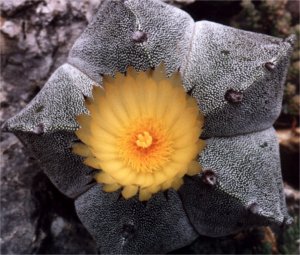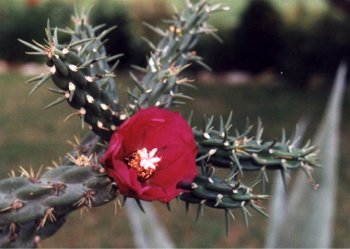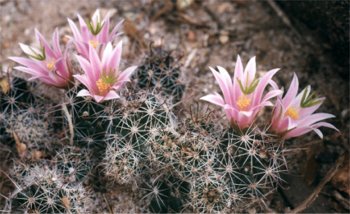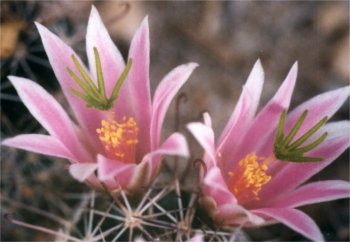|
There are so many different and interesting cactuses in our gardens, that a second part to this subject was necessary.
The next cactus (probably Mammillaria sp.) shown blooms for only one day. It is a very small species and was growing in a rather unprotected spot for a couple of years before it started blooming. The closest identification I could come up with is that it is similar to Mammillaria blossfeldiana, but the flowers are a different color. Although small, the blossoms are so intricate, with their pink and white petals, yellow anthers and green stigma, that a closer look is necessary to fully appreciate them.
A rather unassuming, ordinary looking cactus, shown below, the Texas pride (Thelocactus bicolor), has gorgeous bright pink blossoms with red centers. Although the blooms are produced one at a time, they are bigger than the plant itself. This cactus comes from Texas and northern Mexico.
I have noticed that most books on cactus give minimum night temperatures for the well-being of the plants. However, the plants we have only seem to be affected by real extremes of hot and cold, needing to actually reach freezing level before they suffer any ill effects. Our temperatures certainly drop well below the 50°F that is often cited for many species, but if the plants don't actually freeze, they seem unharmed. Before seeing how well they grow and bloom when exposed more to the elements, I had thought that protecting them from extremes of hot and cold would be better, but the next cactus certainly convinced me otherwise.
The bishop's cap, or monk's hood (Astrohytum myriostigma), from northern Mexico, is a very striking cactus with no spines at all. It also seems to have many variants. We had this cactus in a pot for years and it barely grew and never blossomed. After establishing the raised garden, we moved it in and the first summer it began to grow, its covering of white spots becoming very dense in response to the bright sun. It also started to bloom, and regularly produces one or two bright yellow flowers at a time. The large number of petals make these blossoms unusual among our cactuses.
The bright yellow and red flowers of the next cactus (Ferocactus setispinus) are bigger than the plant itself. This cactus occurs in northern Mexico and Texas and is sometimes called twisted rib cactus.

The dwarf chin (Gymnocalycium baldianum) is another of those common cactuses sold in tiny pots at every discount or hardware store garden center. Supposedly, its common name comes from the creases between the protruding areoles, which look like little chins. With hardly any spines, it is a very easy cactus to handle and grows quite slowly. The pink blossoms occur mostly in the spring and often in sequence with several days between the maturation of each.

The final cactus here is the cholla (Opuntia imbricata). This plant needs no protection in our climate, and in fact, it is one of only two cactuses we have that must be pruned. It is about 12 years old, five feet tall, and bloomed for the first time this past spring. There is another plant of the same age on the other side of our driveway, but it gets more sun and is growing slightly slower. Because the spines are so dangerous, with their tiny barbs that make them difficult to remove, we keep them pruned back away from the sidewalk. First year growth is relatively easy to cut through, but if it gets to a second year, the woody inner skeleton is pretty tough. Some chollas have yellow blossoms, but this type has bright pink.
|






